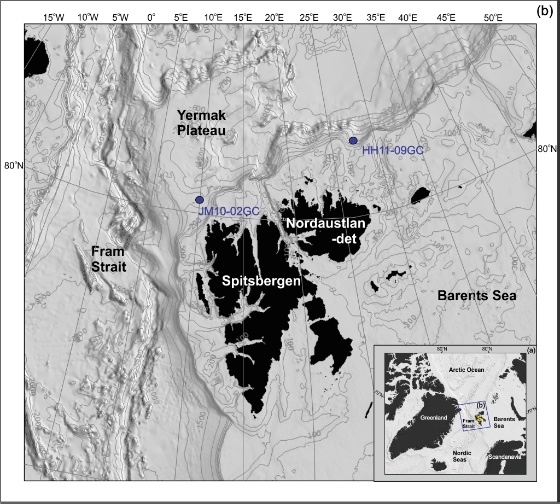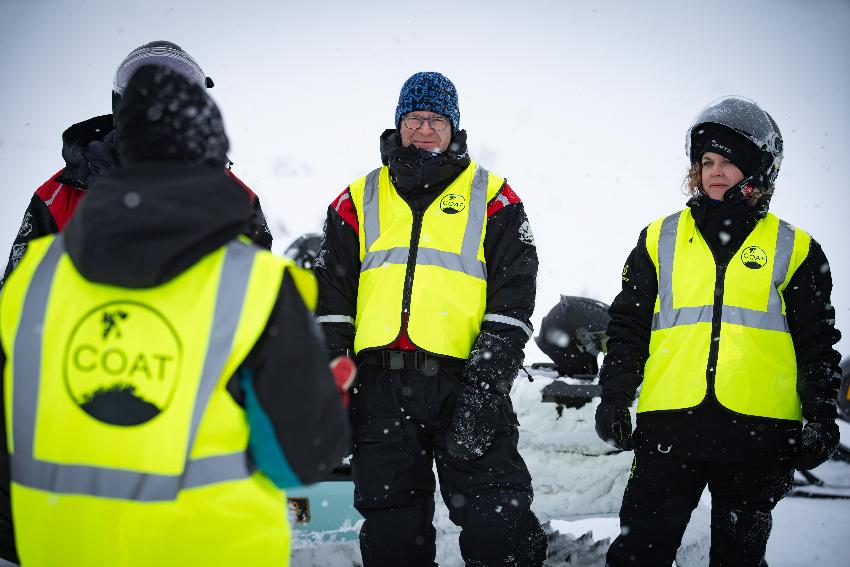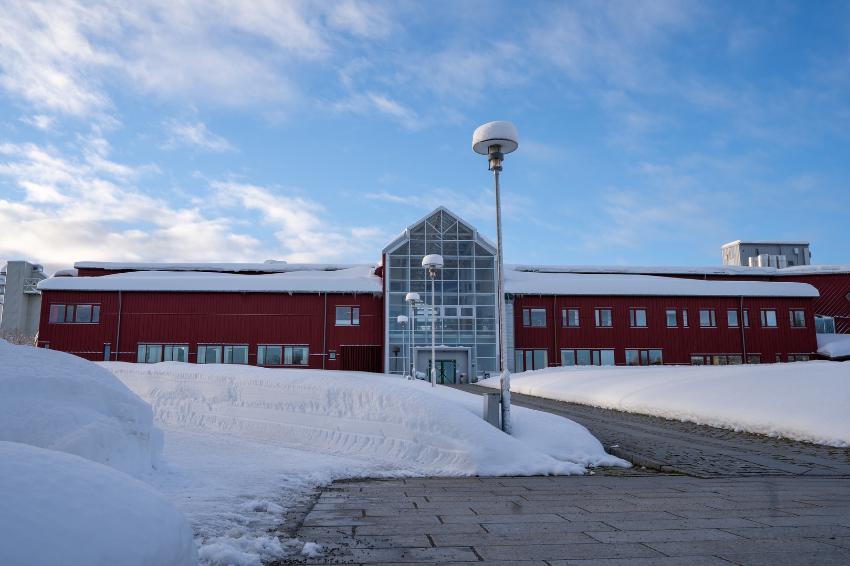A Well-Preserved Climate Archive Can Be Found in Ocean Floor Mud

 |
| Electron microscopy of microfossils; foraminifera exists as benthic organisms (benthic foraminifera) and floating on the surface (planktic foraminifera); and common to them is their living conditions being reflected in their bones and shells. Illustration: Chauhan et al. 2015 |
A clam is not just a clam! Shells and conches that we find on the chalk-white beaches outside of Tromsø are actually key witnesses of the climate of their times. But to find information about the climate thousands of years ago, researchers must literally dive deeper into the archives. More precisely, they must dive to depths of 500-1000 meters to reach the seabed, and further 3-4 meters into the mud and sand. The shells of microscopic mussels (i.e. fomraminifera) contain important and stable historical climate archives.
 |
| Bathymetric chart of waters around Svalbard, showing topography of the sea floor. Blue dots markes the sites of sampling. The mud samples were collected at expeditions with Helmer Hanssen in 2011. Illustration: Teena Chauhan (PhD thesis). |
Retrieved New Climate Data North of Svalbard
Starting on the surface again, Teena Chauhan explains how she has conducted research on the flow of Atlantic waters into the Arctic, and how it has affected ice sheets that cover large portions of Svalbard and the polar seas.
The seabed north of Svalbard has been largely unexplored until now. This has changed in recent years due to increasing periods of ice-free conditions in the area. Chauhan has joined in on missions to obtain sediment samples from the north western and northern parts of the continental margin, with the goal to reconstruct a clearer picture of the flow of the Atlantic waters during the past 132,000 years.
"Reconstruction of sea currents from thousands of years back can tell us a lot about the climate in the past, how it has varied and the factors that have driven these changes," she explains.
| Teena Chauhan and Kamila Sztybor sort through core samples recovered from the ocean floor. The photo was taken during an expedition aboard the research vessel Helmer Hanssen. Photo: Tine Lander Rasmussen |
Warmer Climate, but Still More Ice
-Our studies have confirmed a discovery that is a bit exciting, specifically that "warm periods" with a lot of glacier melting around Svalbard led to the growth of sea ice. This phenomenon occurs when water masses seperate themselves into two layer; salty sea water on the bottom and fresh water from the melting glaciers on top. These two layers hurdle circulation in the water masses and force Atlantic currents from the south to remain under fresh water on the top. Fresh water freezes more easily than sea water, and accoding to our data, led to the fact that the ice sheet around the Arctic increased again.
-During our studies, we uncovered two time periods with global warming. Surprisingly data showed an increase in the amount of sea ice, despite the melting of glaciers in Svalbard ~60,000 years ago and in the period 19000 - 11500, says Chauhan.
 |
| Sketch of a 3.5-meter core sample taken from the ocean floor of Svalbard. The age of the sediments increases from top to bottom along the vertical axis. Climate and ocean currents determine the composition of the different layers, and as we see from the chart, some layers are dominated by shells, while other layers contain most sand and stone. Illustration: Chauhan et al., 2014 |
Microfossils - A Fantastic Historical Archive
The direction and strength of sub-sea currents cause changes in the ocean floor sediments. These sea currents carry with them microorganisms (e.g. foraminifera among others) that live in these waters. When these organisms die, their skeleton/shell will be carried by the ocean currents and deposited on the ocean floor. According to Chauhan, tracking the distribution of such microfossils makes the researches able to propose how ocean circulation has changed over time.
Analyses of carbon isotopes and chemical composition of the shell indicates both the fossils age and the climate conditions while the organism was still alive. Therefore the fossils constitute a fantastic geological archive.
Layers of Sand and Microfossils
The core samples are retrieved from the ocean floor in long, thin tubes. They are typically 3-6 meters long and 10 cm in diameter. The figure on the right visualize how layers with mud and sand can be read like an archive. The material on the lower end can be up to 130,000 years old, while the sand on the top reflects more recent dates.
Chemical Analyses of Ocean Floor Samples
Some of the most important investigations Chauhan conducted were:
- Layer distribution of foraminifera in sediments
- Oxygen isotopes in the shells of the microfossils (shows temperature and salinity)
- Carbon isotopes from the shells (shows the age of the fossils)
- Mapping of sand and stone that have been transported with glaciers and that have decended when the ice melted.
- Size of sand grains
- Organic carbon content (carbon from plants and animals)
Chauhan's results show that the size and stability of the ice sheets have varied over time with changing surface currents from the Atlantic.
Over the last 132,000 years, the Arctic climate has varied much and these changes have proved to be closely connected to the volumes and strengths of northbound Atlantic currents t.
 |
| Teena Chauhan is from India and completed her masters degree in Marine Geology at Cochin University of Science and Technology in India. Before she moved to Svalbard, Chauhan worked for two years at Indias National Institue for Oceanography. |
Teena Chauhan defended her thesis entitled: "Late Quaternary Paleoceanography of the Northern Continental Margin of Svalbard" on the 27th of August 2015. She started her PhD in 2011 and was associated with the department of Arctic Geology, UNIS and the department of Geology at UiT - The Arctic University of Norway. Her PhD advisors during this time were Riko Noormets, UNIS and Tine lander Rasmussen, UiT.
Chauhan is a member of ResClim, the national research school for climate. Her research was funded by The Research Council of Norway.
Referances
Chauhan,T., Rasmussen, T.L., Noormets, R., Jakobsson, M. & Hogan, K., (2014) Glacial history and paleoceanography of the southern Yermak Plateau since 132 ka BP. Quaternary Science Reviews 92, 155-169. http://dxdoi.org/j.quascirev.2013.10.023
Chauhan,T., Rasmussen, T.L., & Noormets, R (2015a) Paleoceanography of the Barents Sea continental margin, north of Nordaustlandet, Svalbard, during the last 74 ka. Boreas (Available Online). doi:10.1111/bor.12135
Chauhan, T., Noormets, R. & Rasmussen, T.L. (2015b) Glaciomarine sedimentation and bottom current activity on the north-western and northern continental margin of Svalbard during the Late Quaternary. Geo-Marine leters (Available Online). doi:10.1007/s00367-015-0430-6




